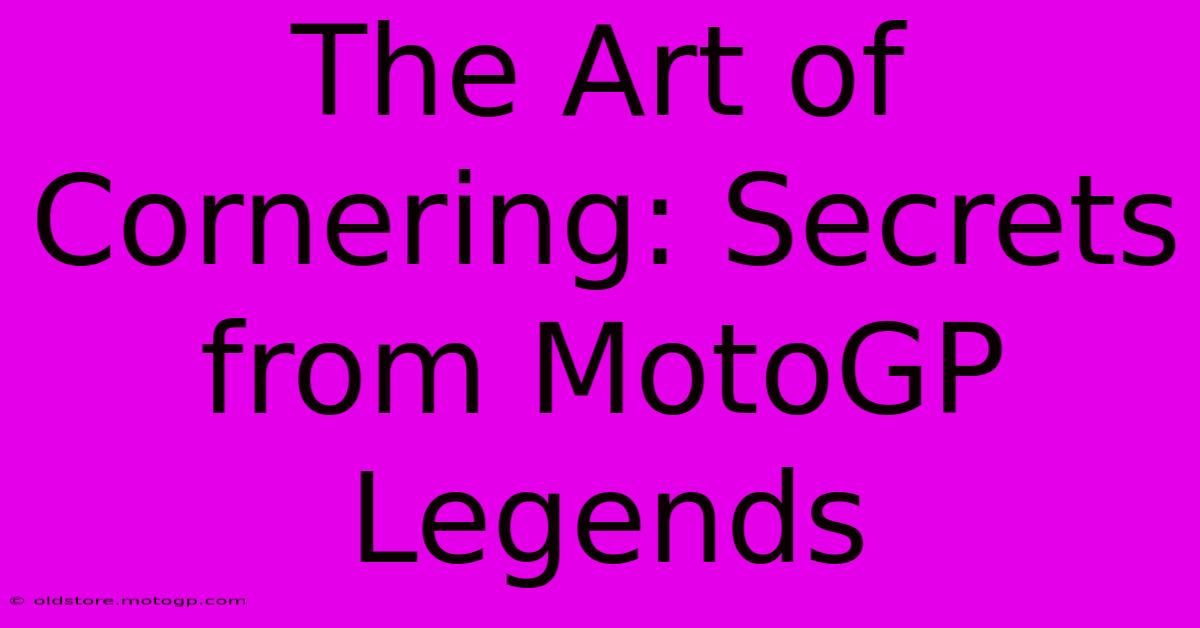The Art Of Cornering: Secrets From MotoGP Legends

Table of Contents
The Art of Cornering: Secrets from MotoGP Legends
MotoGP racing is a breathtaking spectacle of speed, skill, and precision. But beyond the raw power of the machines lies a deep understanding of physics and technique, particularly in cornering. This article delves into the secrets of masterful cornering, drawing insights from the legendary riders who have dominated the sport. Mastering this art is crucial for any aspiring racer, and even understanding the principles can enhance your enjoyment of the sport as a spectator.
Understanding the Physics of Cornering
Before we dive into the techniques, let's briefly touch upon the fundamental physics. Cornering effectively involves managing three key forces:
- Centrifugal Force: This outward force tries to push the bike and rider off the racing line.
- Friction: The grip between the tires and the track surface is crucial for maintaining control and preventing a slide.
- Gravity: This force constantly acts downwards, influencing the bike's stability and lean angle.
MotoGP riders are masters at manipulating these forces to their advantage. They don't simply lean into a corner; they control the lean, using a combination of body positioning, throttle control, and braking techniques to achieve the perfect trajectory.
MotoGP Cornering Techniques: Insights from the Legends
Several techniques are key to the legendary cornering skills exhibited in MotoGP:
1. Trail Braking: A Controlled Slide
Many consider trail braking the most crucial element of fast cornering. This technique involves gradually releasing the brakes while simultaneously leaning into the turn. It allows the rider to maintain higher corner speed while maximizing available grip. Legends like Valentino Rossi and Marc Marquez are masters of this delicate balancing act. The key is precision and control – not simply slamming on the brakes.
2. Body Positioning: One with the Machine
Observe closely and you'll see MotoGP riders aren't just sitting on their bikes; they become one with the machine. Their body position, often described as “hanging off,” shifts the center of gravity, allowing for a greater lean angle without losing stability. This technique is essential for navigating tighter corners at high speeds. Think of the legendary Jorge Lorenzo's precise body control as an example.
3. Smooth Throttle Control: Power and Grace
Sudden acceleration or deceleration can disrupt the delicate balance required for smooth cornering. MotoGP riders use subtle throttle adjustments to maintain momentum and traction throughout the corner. They gradually increase the throttle as they exit, maximizing acceleration without losing control. This smooth control is a hallmark of champions.
4. Line Selection: The Path to Perfection
Choosing the ideal racing line is fundamental to fast cornering. MotoGP riders strategically select their lines to optimize speed and grip throughout the turn. This often involves using the entire track width, finding the most efficient path. Understanding the track's characteristics is critical in this process.
5. Apex Speed: The Art of Balance
The apex, or the point at which the rider is closest to the inside of the corner, is critical. Reaching the apex at the ideal speed requires a careful balance of braking, lean angle, and throttle control. Experienced riders maintain a consistent speed through the apex, smoothly transitioning to acceleration as they exit the corner.
Beyond the Techniques: Mental Strength and Experience
While the techniques described above are essential, MotoGP cornering mastery extends beyond mere technical skill. It demands:
- Mental Focus: The concentration required to execute these techniques at breakneck speeds is immense. Any lapse in focus can have devastating consequences.
- Track Awareness: MotoGP riders have an instinctive understanding of the track surface, anticipating changes in grip and adapting their technique accordingly.
- Years of Practice: The skills discussed are developed only through countless hours of practice and refinement. It's a testament to years of dedication and perseverance.
Conclusion:
The art of cornering in MotoGP is a fascinating blend of physics, technique, and mental fortitude. It's a testament to the incredible skill and dedication of the world's best racers. Understanding these techniques provides a deeper appreciation for the sport, regardless of whether you’re a rider or a fan. The next time you watch a MotoGP race, pay close attention to the riders' body language, throttle control, and line selection – you'll see the secrets of these legends in action.

Thank you for visiting our website wich cover about The Art Of Cornering: Secrets From MotoGP Legends. We hope the information provided has been useful to you. Feel free to contact us if you have any questions or need further assistance. See you next time and dont miss to bookmark.
Featured Posts
-
Fake Motorcycle Helmets Putting Your Life At Risk
Feb 19, 2025
-
Moto2 Specs The Secrets To Winning Races
Feb 19, 2025
-
Tnt Moto Gp The Art Of Motorcycle Racing
Feb 19, 2025
-
Cota Parking Simplify Your Race Day With Lot R
Feb 19, 2025
-
Moto2 Standings 2025 Your Source For Real Time Updates
Feb 19, 2025
